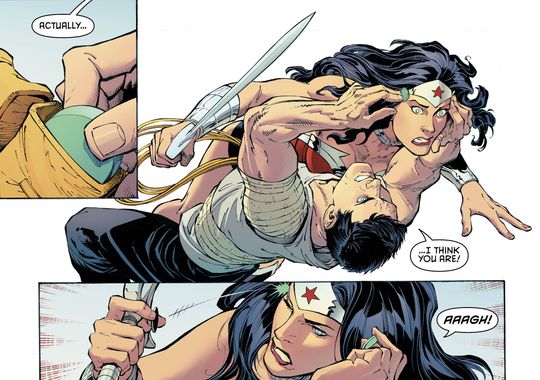
Written by Scott Snyder
Pencilled by Greg Capullo
Inked by Danny Miki
Colors by FCO Plascencia
Published by DC Comics
After spending a year developing the origin and mythos of Batman, Scott Snyder and Greg Capullo turn him loose in Batman #35 and show him at his prime fighting some of Earth’s mightiest heroes. The scale of the comic is huge as Batman battles the various Justice League members, and Capullo’s art shows their might in comparison to Batman’s mortality. The comic opens at the Royal Theatre in Gotham, which has spent lots of money on a special crane so there can be a literal “deus ex machina” in a staging of the Oresteia. Snyder and Capullo stage their narrative like a Greek tragedy giving Batman his own fatal flaw in the story. From Batman #35, it seems that the “Endgame” will be looking at Batman as legend while having many twists and turns along the way. Snyder does a good job showing Batman’s unique contingency plans for stopping the Justice League while Capullo shows them in action from Wonder Woman’s window breaking power to Flash’s crackling super speed. If anything, Batman #35 is an argument for why Greg Capullo should draw Justice League. FCO Plascencia continues to set the mood with his colors from the mix of somber and bright coloring in the theatre to Batman’s shadowy greys and blacks and the various color schemes for the Justice League members.
In “Zero Year”, Scott Snyder and Greg Capullo laid the foundation for Batman as a hero along with his relationship to Gotham, Jim Gordon, Alfred, and various supervillains, most notably the Riddler. In Batman #35, they apply this epic scale to the “modern” Batman. There is definite feel of Grant Morrison’s Batman stories in this issue, but Snyder and Capullo keep the story grounded in the world they’ve been building for Batman for the New 52. A big part of their Batman stories has been structure. Snyder and Capullo have centered their arcs around one literary motif and relationship. In “Court of the Owls”, they chose nursery rhymes and Dick Grayson. For “Endgame”, Snyder and Capullo have chosen Greek mythology and the Justice League for now. These things go together well because DC superheroes have been compared to Olympian deities in texts ranging from Bruce Timm and Alan Burnett’s DC Animated Universe to Grant Morrison’s run on JLA and even William Moulton Marston’s old Wonder Woman stories. However, it is interesting that Snyder and Capullo are bringing in mythological elements (and even objects) to Batman, who some would argue is the least godlike of the major Justice League members. The idea of Batman as mythological hero is explored through both the plot, art, and caption boxes of Batman #35 as Capullo plays Hephaestus to Batman’s Achilles and gives him a shiny (and technologically advanced) piece of armor in his battle against these supergods.
The underlying theme of superheroes as modern day gods adds depth to Snyder’s action-packed plot, which involves a Batman, who seems a little bit happier, but the shadows are always present. This can be seen in Capullo’s gorgeous opening page, which reveals a sumptuously decorated stage with curtains and a suit of armor. But the edges of the ceiling are hard to make out, and Plascencia makes them black in contrast to the low orange and yellow lighting of the stage. Capullo uses hard lines in his composition of the “Bat-mecha” and keeps it ambiguous at the beginning whether Batman is fighting the mecha, or is inside it. This sense of dramatic timing serves well in the transitions when Batman fights the various Justice League members going from the bloody, warlike world of Wonder Woman to The Flash’ s faster than a thought existence. The fights are creatively depicted, suspenseful, and show Capullo’s command of these heroes, their powers, and characterization. Snyder and Capullo are a true team and unpack a lot of thought provoking ideas mixed with earth shattering battles and some surprises in Batman #35, which is an amazing start to the “Endgame” storyline.


